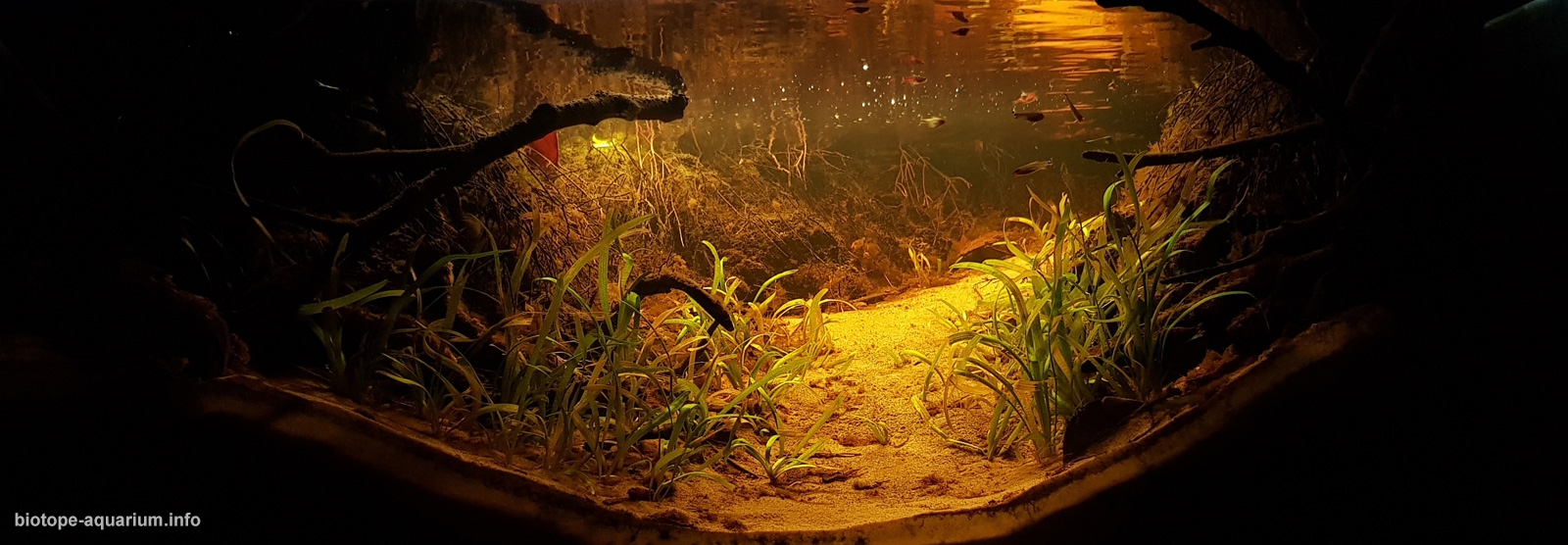Rio Unini and junction to the basin of Rio Negro, Brazil
19th place in Biotope Aquarium Design Contest 2018
![]() Turkey. Ali Türkmen
Turkey. Ali Türkmen

Volume: 240 L
Dimensions: 100x60x40 cm
List of fishes: Paracheirodon axelrodi, Hemigrammus bleheri
List of plants: Sagittaria subulata, Lemna minor
Description of decorations: I only used natural ingredients. There’s fine sand on the floor. Lava rock, Palm pieces. I used magnolia pieces and leaves.
Description of equipment: Eheım 2171, 4 pcs 14 watt 6500 kelvin T5.
Water parameters: Temperature 26°C, KH 3, pH 6.3.
INFORMATION ABOUT BIOTOPE
Description of the area surrounding the biotope: Rio Negro, major tributary of the Amazon. It originates in several headstreams, inculiding the Vaupés (Mapes) and the Guainía, which rise in the rain forest of eastern Colombia. The Guainía flows east and then arches northwest and south east, forming the Colombian Venezuela border. Below its junction neat San Carlos de Rio Negro with the Brazo Casiquare, a natüralist waterway that brings waterway from the Orinoco River in Venezuela, the river acquires the name Negro and enters Brazil. The Negro meanders generally east southeastward, picking up the Branco River and other tributaries, to Manaus. There it joins the Solimoes River to form the Amazon. Its length is about 2250 km, of which 1370 km are in Brazil. It is navigable for about 725 km above its mouth. Although settlement along its banks is sparse, the river is a major transportation artery. The Clear jet black colour of the Negro’s water, whence decomposition of organic matter in marginal swamps and its low silt content. The black waters contrast dramatically with the yellowish silt-laden waters of the Branco and with the Amazon. The rainforests of the Amazon basin have evolved as a part of a river system whose water level fluctuates annualy by as much as 15 metres or more along the middle and lower Amazon. There are substantial further differences in the quality of water. The Rio Negro river, for example, drains an area of sands low in nutrient elements, where organic matter has accumulated sufficiently in soils to produce the humic acids that give the river its dark colour and animal life it can annual cycle are forested and are known by Portuguese word várzea. Trees in this zone survive flooding for several weeks annualy and provide the basis of a food web that includes fish adapted for grazing on tree fruits and seeds. The grazing fish possess large flat molars adapted for masticating seeds and other coarse organic matter, and they compete for seeds dropped from pods in várzea trees on the river. White the name Rio Negro means black river, its waters are similar in color to strong tea, wich iş typical of blackwater rivers. The dark color comes from humic acid due to incomplete breakdown of phenol-containing
vegetation from sandy clearings. The river was named because it looks black from a distance. Much has been written on thr productivity of the Rio Negro and other blackwater rivers. The older idea that these are hunger river is giving way, with new research, to the recognition that the Rio Negro, for example, supports a large fishing industry and has numerous turtle beaches. If explorers did not find many Indians along the Rio during the 17.century, it is likely that their populations were reduced because of new infectious diseases and warfare rather than low river productivity. Rio Negro has a very high species richnees. About 700 fish species have been documented in the river basin, and it is estimated that the total is 800 – 900 fish species, including almost 100 endemics anda several undescribed species. The Unini River forma where the Água Preta stream joins the Preto River. It then flows east to the Rio Negro, forming the border between the Rio Unini Extractive Rezerve to the north and the Jaú National Park to the south The river basin has about 1500 streams and over 1000 lakes, with an estimated length of 400 km from its mouth to the headwaters. The basin covers about 2.689.644 hectares. The largest tributaries are the Papagaio, Paunini and Solimoezinho streams. The river has generally acidic water with little suspended material. The river and its tributaries make many meanders, creating great divercity of aquatic environments including lakes, rivers, creeks and flooded forests. The river is lowest between October and November, and highest between June and July. Water levels vary from minimum to maximum between 11.26 and 15.75 metres.
Description of the underwater landscape of the biotope: Rio Negro brings a lot of wood pieces, leaves, soil and much more from the rainforest. They all come together anda create great underwater landscape. There are plenty of places where fish anda other creatures can hide.The most prominent feature is the black water.
Description of the parameters of the habitat: Summer season ( June to September ), Temperature 28 ° – 30°, pH : 3.5 – 4, Winter season ( September to May ), Temperature : 23°, pH : 6.
List of fishes and invertebrates occurring in the nature biotope: Paracheirodon axelrodi, Apistogramma diplotaenia,
Hemigrammus bleheri, Nannacara Adoketa, Corydoras amandajanea, Corydoras rabauti, Hemigrammus bellottii, Cichla temensis, Uaru amphiacanthoides.
List of plants found in the nature biotope: Echinodorus tenellus, Eleocharis sp. Echinodorus horizontalis, Sagittaria subulat.
Threats to the ecology: The statistics of international environmental organizations that keep watch in various parts of the Amazon forests, especially in Greenpeace, are not at all heartwarming. In spite of all efforts. For 20 years a football field has been murdered. 50 years after the destruction of forests, it is foreseen that even the countries in Asia will ve affected and will not find the breathing oxygen, Ları If foreigners warn their own countries, we can only save the common lungs of the Amazon, says Marcelo Marquesini of Greenpeace.
When the Portuguese discovered Amazon in the 16. century, the number of all the locals living in the region was 3.5 million. Today is a full tenth of the number, so It’s 350.000. As much as the colonialists of the ancient continent, the gold seekers of the 21. century anda the massacre of the woods have also contributed to this decrease of the population. Because the rich vegetation, as well as gold in the Amazon rainforest, this place has increased the attractiveness of underground wealth. This economic value carried by Amazon has been the target of international smugglers and gold callers as well as international companies. All the needs of the locals who meet from the trees and plants cut off the vessels of life. The inhabitants of Brazilian forests sene themselves as the most unlucky people in the world. Like the entire Amazon basin, the Rio Negro basin is now under threat today due to constant deforestation, uncontrolled expansion of pastures and activities by gold miners. İt is at risk from illegal fishing, mining, forest massacre in Rio Unini. Some fish species, turtles anda birds face the danger of overfishing. The problems in Rio Unini reach the Rio Negro. The problems in Rio Negro could kill the Amazon. Problems with the Amazon cause major problems on our Planet. Amazon’s Life is the heart of Earth.
Sources of information:
https://fish.mongabay.com/
https://www.fishbase.de/
https://www.britannica.com/
https://www.wikizero.pro/m/
Comments of the members of the jury of Biotope Aquarium Design Contest 2018

When I saw this aquarium I said wow. This aquarium looks pretty deep and authentic. It looks too much bigger than 240 litres. You have used here golden cut and perspective rules very well. Well done. You might use more plants on backside. Photos and video is not bad but could be better. I really would like to see different species which belong to habitat of Unini in this biotope. I think, this is best designed and realistic aquarium of this year. Good job, congrats.
